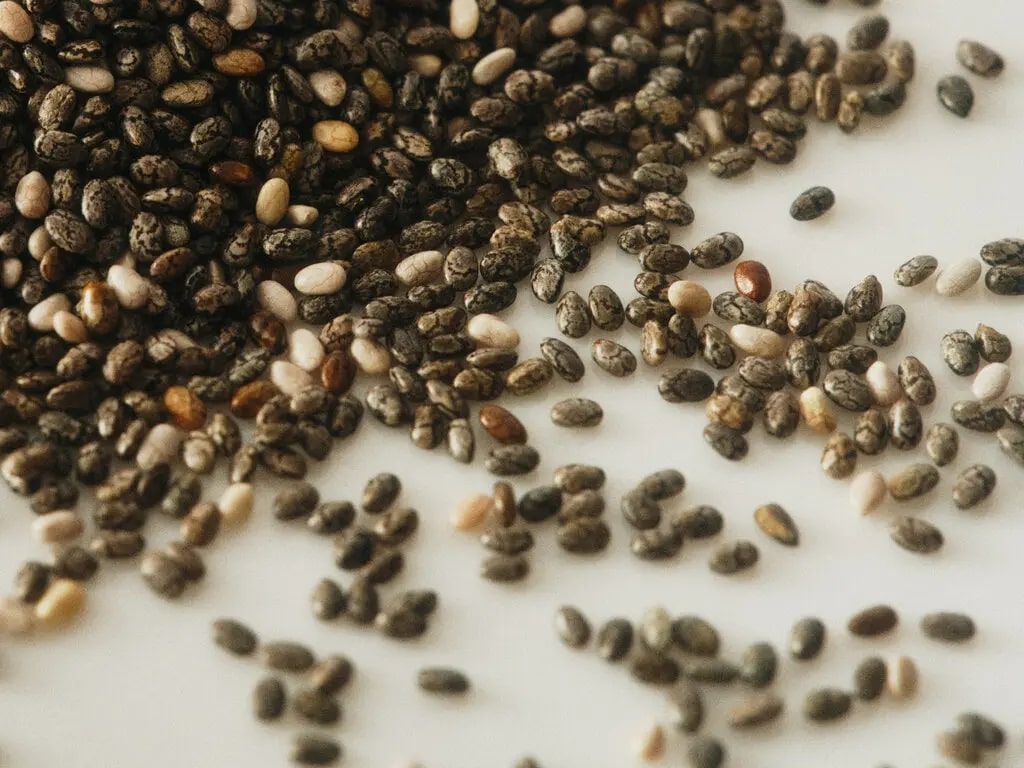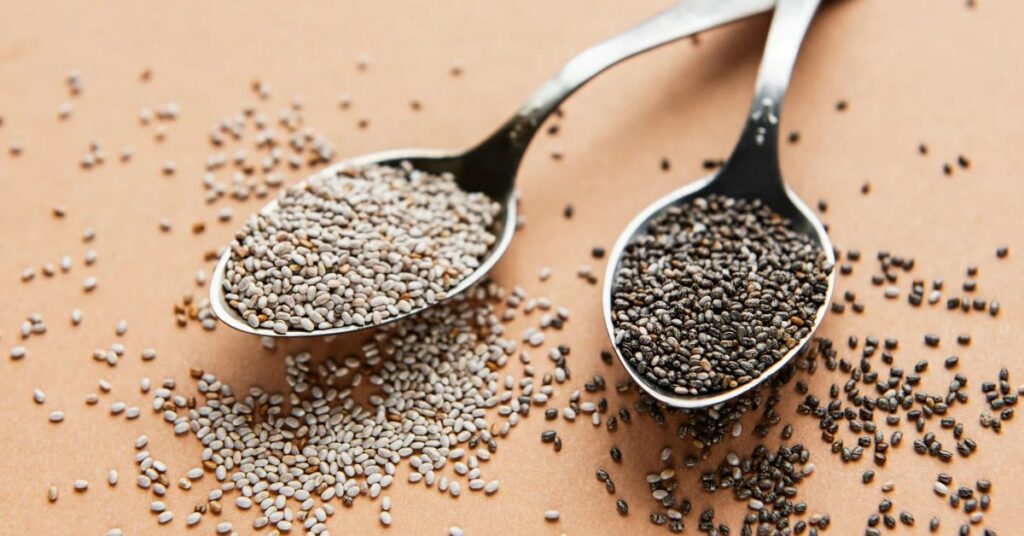Did you know that chia seeds are more than just a health fad? It boasts its own rich history, even dating back to ancient civilizations.
Read on to learn more about chia seeds, their history, and their benefits to humans.
What is a chia plant?
Chia is an annual flowering plant from the mint family native to Northern Guatemala and Southern Mexico. It is widely cultivated for the seeds it produces due to its high nutritional and medicinal benefits.
This perennial herb thrives in hot, dry climates and sandy loam soils, requires little watering and can even survive desert conditions.
The chia plant has sparingly branched hairy stems that can grow up to 3 feet tall. It produces opposite leaves and blooms tiny blue, white or purple flowers.
The chia seeds are easily identifiable through their oval shape and gray, brown, and black seeds with white spots.
Once the chia plant loses its petals and flowers in the fall, it will divert all its energy to produce seed pods that generate 500 to 600 kilograms of seeds per acre.
Chia seeds have become a worldwide superfood because of their versatility, high nutrient, antioxidant and antimicrobial properties. It’s rich in omega-3 fatty acids, dietary fiber, protein and antioxidants that help reduce a number of diseases.
Where do chia seeds come from?
Chia seeds come from the chia plant botanically known as Salvia hispanica. These edible seeds were cultivated as early as 900 BC by the ancient Mayan and Aztec civilizations for food, religious rituals and cosmetics.
The word chia means “oily” in the Aztec language called Nahuatl. These ancient civilizations widely cultivated chia seeds in the Central Valley of Mexico and used them to extract oil, ground them for flour or feed them to poultry.
The Mayans and Aztecs recognized the seeds’ benefits to the human body and used them as a natural remedy to relieve soreness or joint pains.
They were also central to the Aztec and Mayan soldiers’ diets. They believed it gave them energy and vitality and that one tablespoon could sustain a person for 24 hours.
How are chia seeds grown and harvested?
Chia seeds are grown from the chia plant Salvia hispanica, whose seeds are sown during spring and will flower about 100 to 180 days after planting. Once the flower heads are dry, the chia seeds are extracted and spread out to dry.
Chia seeds are now harvested using machinery, as each commercial chia cornfield can generate between 1,000 to 2,100 pounds of chia seeds per acre.
These machines usually run along the chia plant rows in the field to remove the seed heads. The seed heads will then be brought to the processing plant, where chia seeds are removed from the seed pod and cleaned against dirt, bugs and other contaminants.
What is the nutritional value of chia seeds?
Despite their miniature size, chia seeds are rich in fiber, omega-3 fatty acids, protein and other micronutrients.
According to the United States Department of Agriculture Research Service, one ounce or about two tablespoons (28.35 grams) of chia seeds contains the following:
| Nutrient | Amount |
| Water | 1.64 grams |
| Energy | 138 kcal or 576 kJ |
| Protein | 4.68 grams |
| Lipid | 8.7 grams |
| Carbohydrate | 11.9 grams |
| Dietary fiber | 9.75 grams |
| Calcium | 179 mg |
| Iron | 2.19 mg |
| Magnesium | 95 mg |
| Phosphorus | 244 mg |
| Potassium | 115 mg |
| Sodium | 4.54 mg |
| Zinc | 1.3 mg |
| Manganese | 0.771 mg |
| Vitamin B1 | 15% of the daily value |
| Vitamin B3 | 16% of the daily value |
What are the health benefits of chia seeds?
Chia seeds are an excellent source of nutrients and antioxidants, linked to cell damage and inflammation prevention, reduced risk for heart disease, improved blood sugar level and bone health, and weight loss.
Learn about each health benefit of chia seeds below.
1. Chia seeds prevent cell damage and inflammation.

Chia seeds contain kaempferol, myricetin, and quercetin, which protect the heart and liver and have anti-cancer properties. It also has chlorogenic acid, which helps lower blood pressure and caffeic acid to prevent inflammation.
Chia seeds are also an excellent source of antioxidants. The seeds contain compounds that protect the seed from going rancid while offering health benefits, such as preventing damage from free radicals in the body.
2. Chia seeds promote weight loss.
Chia seeds are rich in dietary fiber and protein that can be a valuable addition to a balanced and more nutritious diet to aid weight loss.
Every ounce of chia seeds has 10 grams or 35% dietary fiber, significantly preventing obesity. So, a small intake of chia seeds will make you feel full and reduce your hunger and cravings and overall calorie intake.
For instance, a study showed that chia seeds added to yogurt led to reduced food intake in individuals.
3. Chia seeds reduce the risk of heart disease.
Chia seeds reduce the risk of heart disease because of their high fiber, omega-3 fatty acid and ALA content.
The soluble fiber and omega-3 fatty acids in chia seeds help lower bad cholesterol in the blood, reducing the risk of heart disease.
Studies have also shown a significant reduction in blood pressure levels of people suffering from hypertension, a risk factor for developing heart diseases.
4. Chia seeds improve bone health.
Chia seeds are also packed with minerals like calcium, magnesium and phosphorus linked to improved bone health.
So, regular consumption of these nutrients from chia seeds will help maintain a good bone mineral density that keeps the bones strong.
5. Chia seeds lower blood sugar levels.
Incorporating chia seeds into your diet will help lower blood sugar levels thanks to their high fiber content and other beneficial compounds.
A recent study found that eating bread with chia seeds has helped lower blood sugar levels in healthy adults compared to those without them.
With lower blood sugar levels aided by chia seeds, you’ll also get a reduced risk for heart diseases, like hitting two birds with one stone.
How do you consume chia seeds?
Chia seeds can be eaten raw, soaked, or added to oatmeal, smoothies or baked goods. They are also great at absorbing water and fat, so that you can use them as a sauce thickener or an egg substitute.
Chia seeds have a mild nutty flavor, often likened to poppy seeds. When eaten dry, they crunch, but once soaked in liquid, they can absorb up to 12 times their weight and develop a creamy gel texture.
These seeds are commonly soaked in milk or added to food and beverages like yogurt, oatmeal, salad dressing, puddings and even cookies.
Although chia seeds can easily be added to your diet, the recommended dosage is 0.7 ounces or 1.5 tablespoons (20 grams) of chia seeds twice per day only.
Don’t forget to drink a lot of water to prevent digestive side effects like bloating or diarrhea from overeating in one sitting.
Is there a difference between black and white chia seeds?

The only difference between black and white chia seeds is explained by genetics. White chia seeds are produced by chia plants with white flowers and vice versa.
However, there is no difference between white and black chia seeds regarding taste and nutritious value. Both still have the same nutritional composition and the same mild nutty flavor.
FAQs on Chia Seeds
Chia seeds come from the mint family’s flowering plant called Mexican chia (Salva hispanica). It is a native crop from Mexico and Guatemala grown for its edible seeds.
Chia plants thrive in warm climates, specifically in the Central and Southern United States (USDA Zones 8 to 11).
Chia seeds can be eaten raw and are usually added to beverages and baked goods as toppings. It is also a thickening agent to replace eggs or other dairy products in vegan dishes.
Chia seeds should either be black, brown or gray with white spots. Do not buy uniformly brown chia seeds because they are immature, giving you less nutritional benefits and a bitter taste.
Chia seeds have a shelf life of 4 to 5 years.





